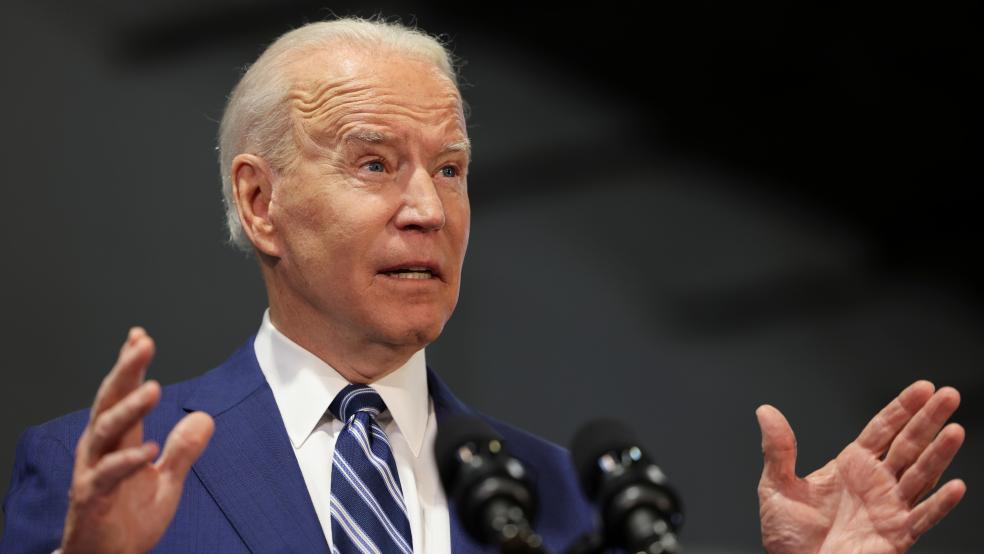The White House on Friday released President Joe Biden’s budget request for 2022, detailing proposals to invest in areas such as infrastructure, education and health care.
The $6 trillion budget ties together Biden’s previously announced plans on infrastructure, the $2.3 trillion American Jobs Plan, and social programs, the $1.8 trillion American Families Plan, along with other proposed changes that fall under the government’s $1.5 trillion in annual discretionary spending. Combined, the budget amounts to an ambitious expansion of the federal government’s spending and taxation aimed at reshaping the U.S. economy to make it more equitable and competitive with countries like China.
“Put together, this budget is an agenda for robust, durable economic growth and broadly shared prosperity,” said Shalanda Young, Biden’s acting White House budget director. “It will deliver a strong economy now and for decades into the future.”
The blueprint will face stiff pushback from congressional Republicans who object to its increases in spending, taxes and debt, but the release will also allow Democrats to move ahead with the special budget process called reconciliation that could provide them a path to enact their agenda without GOP support.
Here’s an overview of the key numbers in Biden’s budget:
$6 trillion: Biden’s proposed level of federal spending for fiscal year 2022. That’s down from a projected $7.2 trillion this year and about $6.6 trillion in 2020 — but spending in those two years was elevated due to emergency pandemic-related legislation. Federal spending first topped $4 trillion in fiscal year 2018 and grew to just over $4.4 trillion the following year. Biden’s budget calls for sustaining spending at a much higher level for years, and it projects annual federal outlays growing to more than $8.2 trillion by 2031.
$5 trillion: The total amount of new spending and tax breaks Biden proposes over 10 years.
$1.8 trillion: The 2022 deficit under Biden’s budget (equal to about 7.8% of GDP), down from $3.7 trillion (or 16.7% of GDP) in 2021. Deficits under Biden’s budget would fall after next year but still top $1.3 trillion a year through 2031. As a share of GDP, the deficit would stay between 4.2% and 5.6% for the rest of the decade, averaging 5.2% from 2022 through 2031.
$1.4 trillion: The debt Biden’s proposals would add by 2031 (equal to about 0.5% of gross domestic product) relative to the White House’s baseline projections. The added debt would bring the cumulative total over the next 10 years to $14.5 trillion.
The $5 trillion in new initiatives Biden proposes is partially offset by $3.6 trillion in tax increases, though the administration says that the higher tax revenues will fully offset the added spending after 15 years. “Because new spending in the budget is heavily frontloaded, the proposal would reduce deficits beginning in 2030 and would fully offset new spending by 2038,” the Committee for a Responsible Federal Budget explains. The White House says that the budget proposals would reduce deficits by more than $2 trillion in the second decade.
117%: The projected level of debt as a share of the economy by the end of fiscal year 2031, up from 100% at the end of fiscal 2020 and a projected 110% at the end of this year.
$914 billion: Projected net interest costs in 2031 under Biden’s proposal, up from $303 billion this year. The budget projects that interest on public debt as a share of the economy will rise from an estimated 1.6% this year to 2.9% by 2031, as those interest payments climb from about 5% of total outlays to nearly 12%. But the budget says that inflation-adjusted interest “would remain at or below 0.5 percent of the economy throughout the next 10 years, well below the historical average.”
16.5%: Biden’s proposed increase in non-defense discretionary spending for 2022. The Department of Education would see a 41% bump, the Department of Commerce would get a 20% increase and the Department of Health and Human Services would get a 23% boost.
1.6%: Biden’s proposed increase in defense spending. Over the longer term, military spending under Biden’s plan would decline as a share of the economy. Republicans say that the president is shortchanging national defense by calling for $224 billion less in defense spending over the next decade than under current law, while progressives are pushing for steeper cuts.
1.9%: Average annual GDP growth projected in Biden’s budget from 2027 through 2031. “Some analysts suggested that the administration is essentially admitting that its proposed surge in federal spending — which administration officials hope to offset over time with higher taxes on the rich and corporations — won’t actually boost the economy much at all,” Politico’s Ben White reports.
The White House said that the economic forecasts were prepared in February, before the White House formally introduced the American Jobs Plan and the American Families Plan, and did not fully factor in those proposals. Council of Economic Advisers Chair Cecilia Rouse told reporters that seemingly small differences in GDP growth can add up to trillions of dollars in additional economic output over time. Other sources told Politico’s White that Biden’s plans could produce stronger growth, but current models can’t account for that. The White House reportedly was also looking to be conservative with its forecasts, in contrast to the Trump administration's track record of overly rosy projections.





